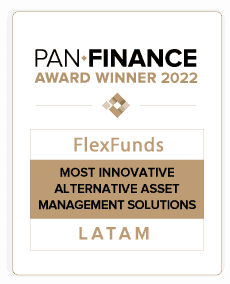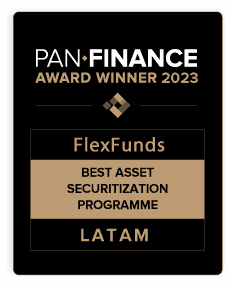Considered a hybrid instrument as it has fixed and variable income characteristics, FIBRAs allow acquiring shares in real estate without buying the asset directly, serving as a gateway for more people who remain isolated from such investments.
Real estate imposes itself as a source of portfolio diversification for asset managers and investors, offering different types of exposure according to their risk profile in residential or commercial sectors.
Considering this aspect, investors can make direct investments betting on future valuations of these properties or obtain exposure through different vehicles that can help them maximize their capital amid high currency fluctuations in different markets.
The U.S. firm FlexFunds specializes in developing independent investment vehicles and explains that one of the options for those who do not wish to invest directly in real estate is the so-called Infrastructure and Real Estate Trusts (FIBRAs). It’s a bridge for financing real estate assets through issuing certificates in the stock market.
FIBRAs allow different investor profiles to have exposure to the real estate market regardless of having the capital to acquire such assets. This tool is responsible for pooling several investors’ money to participates in the industry and generate returns in various real estate assets ranging from offices to shopping malls.
The advantage of the FIBRAs, additionally to the liquidity it offers and the diversification of portfolios, is that it is considered one of the most defensive alternatives in times of volatility such as the current ones, given its low correlation with the performance of other types of assets.
“They are vehicles that have the particularity of receiving constant flows of resources, due to the medium- and long-term lease commitments they have acquired with their tenants,” highlights an expert of the professional services company Deloitte.
Behind the structuring of such strategies is FlexFunds, which contributes to simplify the processes of investing in real estate and facilitates capital raising through its Flex Private Program, mainly focused on the real estate sector.
This program allows developers, managers, and real estate funds to expand and simplify the distribution of their strategies, accessing international investors efficiently. Among the main advantages is access to global private banking and exposure to equity and debt investment instruments through Euroclear-listed security.
How to invest in FIBRAs?
To invest in FIBRAs, the first thing to do is to identify the entity with such instruments and evaluate whether the proposed strategies fit your risk profile. You must consider factors ranging from their advantages to the costs associated with the services, as explained by the Spanish financial institution BBVA.
Once this task is completed, the investor must sign the contract, acquire the securities (or shares) and then transfer the capital to the trustee, which acts as administrator and owner of the real estate, so that the legal responsibilities and the duty to distribute the returns generated fall on the trustee.
Finally, it is essential for investors to constantly monitor the performance of FIBRAs to determine if they are meeting their goals, so it is vital to analyze the results reports that these organizations should present every quarter.
FIBRAs’ U.S. peers are real estate investment trusts (REITs), publicly traded companies that generate returns through real estate management.
According to information from the social investment and asset brokerage firm eToro, REITs have come to outperform stocks over the long term. “Between 1972 and 2019, for example, the FTSE NAREIT index returned 13.3% annually. That was higher than the return of the S&P 500 index, which delivered a 12.1% annual return,” he notes.
A landscape of opportunity
The economic turbulence caused by the post-pandemic period led more investors to seek refuge in the real estate sector, which, in addition to securing capital amid the devaluation of currencies in emerging markets, can help maximize it in the long term despite inflation growth, according to diverse sources.
According to Statista estimates, the size of the global real estate market could jump from the US$10 billion forecast in 2022 to US$14.6 billion in 2030, with momentum in the leading industrial and commercial segments as public spending on infrastructure also rises.
The return to specialty after the pandemic hit meant a resurgence of many real estate segments, including offices, hotels, and retail.
The pandemic generated profound transformations in the real estate sector. Still, the return to normality after the extensive confinements brought new trends that whet investors’ appetite for new opportunities currently supported by the hybrid and collaborative work model.
And although monetary policies have already tightened in many markets, demand has withstood the headwinds with the result that “commercial real estate has succeeded in 2022″ and “the overall industry outlook remains positive heading into the second half of the year,” according to a recent report signed by JP Morgan Chase Commercial Real Estate Director Alfred Brooks.
With this outlook, the dynamics of the real estate sector remain firm despite the challenges outlined for the coming months in the face of the recession in developed economies such as the U.S. Asset managers and investors aim to diversify their portfolios to seek the highest possible returns in an environment that, as well as challenges, could bring many opportunities.
Sources:
- https://www2.deloitte.com/mx/es/pages/dnoticias/articles/invertir-en-fibras.html
- https://www.bbva.mx/educacion-financiera/ahorro/invertir-en-fibras.html
- https://www.etoro.com/news-and-analysis/investing/consider-reits-for-your-portfolio/
- https://www.statista.com/statistics/1289905/global-real-estate-market-size/
- https://www.jpmorgan.com/commercial-banking/insights/2022-midyear-commercial-real-estate-outlook







